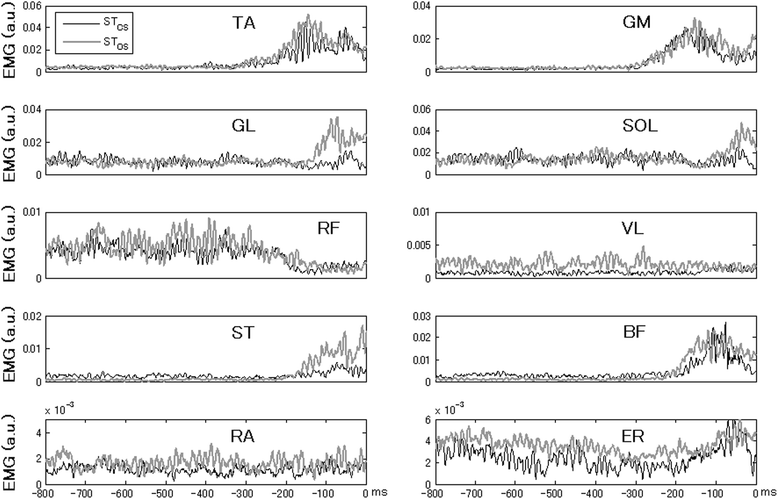Muscle synergies in preparation to a step made with obstacle in elderly individuals
- PMID: 25656738
- PMCID: PMC4326291
- DOI: 10.1186/s12984-015-0005-9
Muscle synergies in preparation to a step made with obstacle in elderly individuals
Abstract
Background: To evaluate if multi-muscle synergies are comprised of flexible combinations of a small number of postural muscles to stabilize the center of pressure (COP) shift during preparation to making a step in the elderly (self-paced level stepping vs. obstacle crossing stepping).
Methods: Electromyography (EMG) signals of leg and trunk muscles were recorded. Linear combination of integrated indices of muscle activity (M-modes) and their relationship to changes in the COP shift in the anterior-posterior (AP) direction were first determined. Uncontrolled manifold (UCM) analysis was performed to determine the extent to which variance of the M-modes acted to produce a consistent change in the COP displacement.
Results: The elderly were capable of stabilizing the COPAP coordinate based on co-varied involvement of the M-modes. The synergy index (∆V) changes in the elderly emerged later (100 ms prior to t0) and its magnitude was smaller as compared to that reported in younger persons.
Conclusions: Our study reveals that aging is associated with a preserved ability to explore the flexibility of the M-mode compositions but a decrease ability to use multi-M-mode synergies following a predictable perturbation.
Figures





Similar articles
-
Aging effect on muscle synergies in stepping forth during a forward perturbation.Eur J Appl Physiol. 2017 Jan;117(1):201-211. doi: 10.1007/s00421-016-3514-8. Epub 2016 Dec 21. Eur J Appl Physiol. 2017. PMID: 28004203
-
Multi-muscle synergies in elderly individuals: preparation to a step made under the self-paced and reaction time instructions.Exp Brain Res. 2013 May;226(4):463-72. doi: 10.1007/s00221-013-3449-9. Epub 2013 Apr 10. Exp Brain Res. 2013. PMID: 23571498
-
Muscle synergies involved in shifting the center of pressure while making a first step.Exp Brain Res. 2005 Nov;167(2):196-210. doi: 10.1007/s00221-005-0012-3. Epub 2005 Nov 15. Exp Brain Res. 2005. PMID: 16034579
-
Muscle synergies during voluntary body sway: combining across-trials and within-a-trial analyses.Exp Brain Res. 2006 Oct;174(4):679-93. doi: 10.1007/s00221-006-0513-8. Epub 2006 May 19. Exp Brain Res. 2006. PMID: 16710681
-
Age-related modifications of muscle synergies during daily-living tasks: A scoping review.Clin Biomech (Bristol). 2024 Mar;113:106207. doi: 10.1016/j.clinbiomech.2024.106207. Epub 2024 Feb 15. Clin Biomech (Bristol). 2024. PMID: 38367481
Cited by
-
Effect of plantar cutaneous inputs on center of pressure during quiet stance in older adults.J Exerc Sci Fit. 2016 Jun;14(1):24-28. doi: 10.1016/j.jesf.2016.02.001. Epub 2016 Apr 21. J Exerc Sci Fit. 2016. PMID: 29541114 Free PMC article.
-
Muscle Synergy Alteration of Human During Walking With Lower Limb Exoskeleton.Front Neurosci. 2019 Jan 29;12:1050. doi: 10.3389/fnins.2018.01050. eCollection 2018. Front Neurosci. 2019. PMID: 30760972 Free PMC article.
-
Old adults preserve motor flexibility during rapid reaching.Eur J Appl Physiol. 2017 May;117(5):955-967. doi: 10.1007/s00421-017-3584-2. Epub 2017 Mar 14. Eur J Appl Physiol. 2017. PMID: 28293798 Free PMC article.
-
Effect of dance on multi-muscle synergies in older adults: a cross-sectional study.BMC Geriatr. 2019 Dec 3;19(1):340. doi: 10.1186/s12877-019-1365-y. BMC Geriatr. 2019. PMID: 31795946 Free PMC article.
-
Aging effect on muscle synergies in stepping forth during a forward perturbation.Eur J Appl Physiol. 2017 Jan;117(1):201-211. doi: 10.1007/s00421-016-3514-8. Epub 2016 Dec 21. Eur J Appl Physiol. 2017. PMID: 28004203
References
Publication types
MeSH terms
LinkOut - more resources
Full Text Sources
Other Literature Sources
Medical

